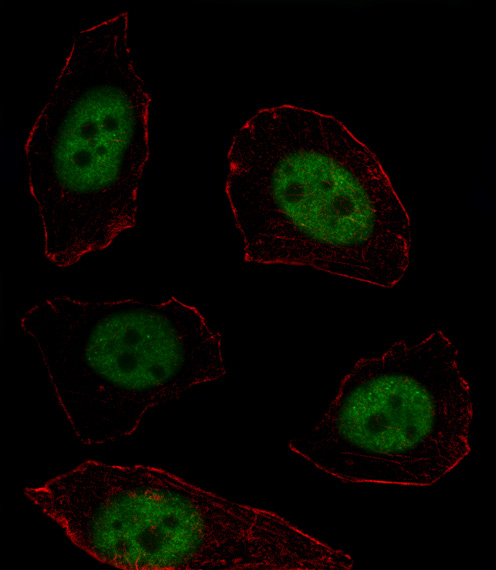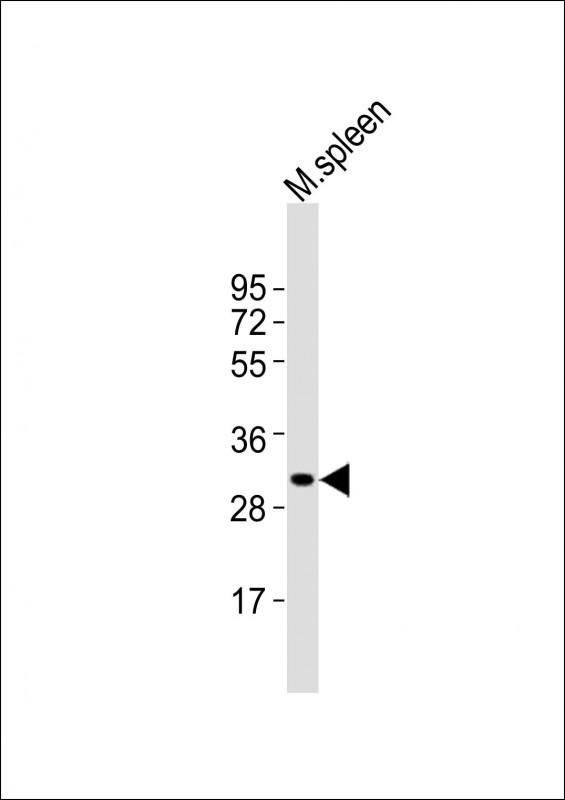MSX1 Antibody (Center)
Affinity Purified Rabbit Polyclonal Antibody (Pab)
- SPECIFICATION
- CITATIONS
- PROTOCOLS
- BACKGROUND

Application
| WB, IF, E |
|---|---|
| Primary Accession | P28360 |
| Other Accession | O02786, NP_002439.2 |
| Reactivity | Human, Mouse |
| Predicted | Bovine |
| Host | Rabbit |
| Clonality | Polyclonal |
| Isotype | Rabbit IgG |
| Calculated MW | 31496 Da |
| Antigen Region | 111-138 aa |
| Gene ID | 4487 |
|---|---|
| Other Names | Homeobox protein MSX-1, Homeobox protein Hox-7, Msh homeobox 1-like protein, MSX1, HOX7 |
| Target/Specificity | This MSX1 antibody is generated from rabbits immunized with a KLH conjugated synthetic peptide between 111-138 amino acids from the Central region of human MSX1. |
| Dilution | WB~~1:1000 IF~~1:200 E~~Use at an assay dependent concentration. |
| Format | Purified polyclonal antibody supplied in PBS with 0.09% (W/V) sodium azide. This antibody is purified through a protein A column, followed by peptide affinity purification. |
| Storage | Maintain refrigerated at 2-8°C for up to 2 weeks. For long term storage store at -20°C in small aliquots to prevent freeze-thaw cycles. |
| Precautions | MSX1 Antibody (Center) is for research use only and not for use in diagnostic or therapeutic procedures. |
| Name | MSX1 (HGNC:7391) |
|---|---|
| Function | Acts as a transcriptional repressor (By similarity). Capable of transcription autoinactivation (By similarity). Binds to the consensus sequence 5'-C/GTAAT-3' in downstream activin regulatory elements (DARE) in the gene promoter, thereby repressing the transcription of CGA/alpha-GSU and GNRHR (By similarity). Represses transcription of myoblast differentiation factors (By similarity). Binds to core enhancer regions in target gene promoters of myoblast differentiation factors with binding specificity facilitated by interaction with PIAS1 (By similarity). Regulates, in a stage-specific manner, a developmental program of gene expression in the fetal tooth bud that controls odontoblast differentiation and proliferation of dental mesenchymal cells (By similarity). At the bud stage, required for mesenchymal molar tooth bud development via facilitating reciprocal signaling between dental epithelial and mesenchymal cells (By similarity). May also regulate expression of Wnt antagonists such as DKK2 and SFPR2 in the developing tooth mesenchyme (By similarity). Required for BMP4 expression in dental mesenchyme cells (By similarity). Also, in response to BMP4, required for BMP4 expression in neighboring dental epithelial cells (By similarity). Required for maximal FGF4-induced expression of SDC1 in dental mesenchyme cells (By similarity). Also in response to SDC1, required for SDC1 expression in neighboring dental epithelial cells (By similarity). At the early bell stage, acts to drive proliferation of dental mesenchyme cells, however during the late bell stage acts as an homeostatic regulator of the cell cycle (By similarity). Regulates proliferation and inhibits premature mesenchymal odontogenesis during the bell stage via inhibition of the Wnt signaling component CTNNB1 and subsequent repression of the odontoblast differentiation factors BMP2, BMP4, LEF1, ALPL and BGLAP/OCN (By similarity). Additionally, required for correct development and fusion of the palatal shelves and embryonic mandibular formation (By similarity). Plays a role in embryonic bone formation of the middle ear, skull and nasal bones (By similarity). Required for correct formation and thickness of the nail plate (By similarity). May play a role in limb-pattern formation (By similarity). |
| Cellular Location | Nucleus {ECO:0000250|UniProtKB:P13297}. Note=Interaction with PIAS1 is required for localization to the nuclear periphery (By similarity). {ECO:0000250|UniProtKB:P13297} |

Thousands of laboratories across the world have published research that depended on the performance of antibodies from Abcepta to advance their research. Check out links to articles that cite our products in major peer-reviewed journals, organized by research category.
info@abcepta.com, and receive a free "I Love Antibodies" mug.
Provided below are standard protocols that you may find useful for product applications.
Background
This gene encodes a member of the muscle segment homeobox gene family. The encoded protein functions as a transcriptional repressor during embryogenesis through interactions with components of the core transcription complex and other homeoproteins. It may also have roles in limb-pattern formation, craniofacial development, particularly odontogenesis, and tumor growth inhibition. Mutations in this gene, which was once known as homeobox 7, have been associated with nonsyndromic cleft lip with or without cleft palate 5, Witkop syndrome, Wolf-Hirschom syndrome, and autosomoal dominant hypodontia.
References
References for protein:
1.Sliwinski, T., et al. Cancer Epidemiol 34(5):652-655(2010)
2.Nikopensius, T., et al. Birth Defects Res. Part A Clin. Mol. Teratol. 88(9):748-756(2010)
3.Suazo, J., et al. Am. J. Med. Genet. A 152A (8), 2011-2016 (2010) :
4.Doi, T., et al. J. Pediatr. Surg. 45(6):1187-1191(2010)
5.Jugessur, A., et al. PLoS ONE 5 (7), E11493 (2010)
References for SY5Y (SH-SY5Y; ATCC#CRL-2266): 1. Ross RA, et al. Coordinate morphological and biochemical interconversion of human neuroblastoma cells. J. Natl. Cancer Inst. 71: 741-749, 1983. [PubMed: 6137586]; 2. Biedler JL, et al. Multiple neurotransmitter synthesis by human neuroblastoma cell lines and clones. Cancer Res. 38: 3751-3757, 1978. [PubMed: 29704].
If you have used an Abcepta product and would like to share how it has performed, please click on the "Submit Review" button and provide the requested information. Our staff will examine and post your review and contact you if needed.
If you have any additional inquiries please email technical services at tech@abcepta.com.













 Foundational characteristics of cancer include proliferation, angiogenesis, migration, evasion of apoptosis, and cellular immortality. Find key markers for these cellular processes and antibodies to detect them.
Foundational characteristics of cancer include proliferation, angiogenesis, migration, evasion of apoptosis, and cellular immortality. Find key markers for these cellular processes and antibodies to detect them. The SUMOplot™ Analysis Program predicts and scores sumoylation sites in your protein. SUMOylation is a post-translational modification involved in various cellular processes, such as nuclear-cytosolic transport, transcriptional regulation, apoptosis, protein stability, response to stress, and progression through the cell cycle.
The SUMOplot™ Analysis Program predicts and scores sumoylation sites in your protein. SUMOylation is a post-translational modification involved in various cellular processes, such as nuclear-cytosolic transport, transcriptional regulation, apoptosis, protein stability, response to stress, and progression through the cell cycle. The Autophagy Receptor Motif Plotter predicts and scores autophagy receptor binding sites in your protein. Identifying proteins connected to this pathway is critical to understanding the role of autophagy in physiological as well as pathological processes such as development, differentiation, neurodegenerative diseases, stress, infection, and cancer.
The Autophagy Receptor Motif Plotter predicts and scores autophagy receptor binding sites in your protein. Identifying proteins connected to this pathway is critical to understanding the role of autophagy in physiological as well as pathological processes such as development, differentiation, neurodegenerative diseases, stress, infection, and cancer.

_-_SY5Y.jpg)




